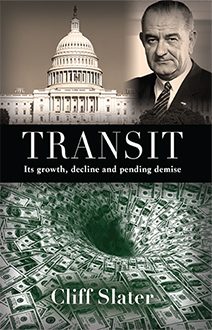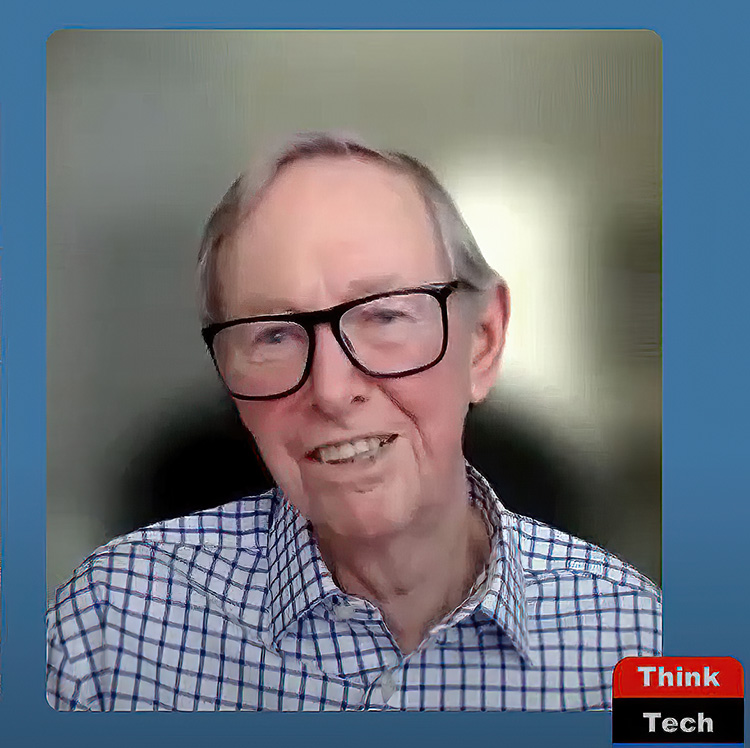|
|
|||||||||
|
| |||||||||

U.S. transit and automotive statistics.xlsx U.S. transit financial data.xlsx Notes on the private turnaround operators.pdf Congressional testimony by private turnaround operators.pdf Consolidation of journey-to-work data.pdf
|
|
"A tour de force. It’s the best explanation I’ve seen of what did and did not happen in urban America leading up to the government takeover of mass transit. A great piece of work." “Truly outstanding. I learned a great deal about the industry that I’ve been working in for over four decades.” “An interesting, factually reasoned summary of public transit over time. I can't wait for it to be published so that practitioners and students in civil engineering and urban planning can benefit from the rich presentation of transit types of service and costs; and use it as a base for their projects and research on existing and novel transit systems." SUPERB! A superb piece of work. Massive research and sound treatment. It will be a major reference. "I greatly enjoyed your book. Good job! Were I still teaching, I would surely assign it.” "Fascinating!"
Buy the book on Amazon, Barnes and Noble, or BookLocker.
Follow us on X (formerly Twitter), and Facebook.
Communicate via email.
March 4, 2024. Think Tech Hawaii's Jay Fidell interviews Cliff: This was a half-hour interview of Cliff (see below) during which Jay said that the book, "is a masterwork spanning a myriad of local and national issues and considerations on the subject and important to anyone interested in knowing where rail is going.” Jay was particularly interested in the future of transit continuing to decline especially with the advent of autonomous vehicles, which I believe may lead to door-to-door service in 4 to 6-passenger vehicles at a price suffienciently attractive to draw a considerable number of riders from transit. His concern was, what happens to rail infrastructure when it becomes obsolete?
The show may be seen HERE. February 28, 2024. Pacific Business News reviews the book: Kam Napier, Editor-in-Chief of PBN, wrote that it "should be required reading for policy makers, and the citizens taxed to fund their mass transit dreams…The book ends on a glimpse of the new vehicles and technologies currently poised to be the final rebuttal to the idea of government-run trains on tracks, as well as the social forces underway — such as the rise of ridesharing apps and remote work — that have accelerated the decline in transit ridership." PBN REVIEW New Geography runs O'Toole's review (see below): NewGeography.com is run by Joel Kotkin, a prolific author of numerous books and articles on demographic, social, and economic trends in the U.S. and internationally. We are honored that he puts the review on the front page. BookLocker, our publisher, offers a free sample: BookLocker, the publisher of TRANSIT, is now offering a free download of Chapter IV to give readers a taste of the rest of the book. Go to their website and at the foot of the book description you will see free excerpt, click on it. Interview by Think Tech Hawaii Yesterday we were interviewed by Jay Fidell of Think Tech Hawaii for a half-hour. It should be up and running on YouTube in a couple of days and as soon as it is, we will post a link here. BookLocker now has us as #1 in their "Ebook Best Sellers" There's nothing more to say about that, see Booklocker.com
CATO Institute's Randal O'Toole writes a review: He comments that it "it's a great book…I heartily recommend Slater’s book to get the full story of how we got here." He also lauds the way we handled the footnotes for the paper version of the book, "One of the great things about Slater’s book is that his associated web site has all of his footnotes with links to the original sources whenever possible. O'TOOLE'S REVIEW
Transit nearing irrelevance: As I mentioned a few days ago, the "riding habit" shown below, is a metric in use in the days when transit was thriving. It is simply the annual transit boardings divided by the urban population. Until 2010 the census of urban population was only taken every ten years for those years ending in zero. Since they fall between decennial censuses, the major effects of the Depression and World War II do not show up. In 1900, for all but the wealthiest, commuting choice was simple, transit or walk. In 1926, the automobile overtook transit, which has decline since then—World War II aside. In 2022 commuting by transit was the choice of only 3.8% of all workers.
Why was President Johnson on the book cover? I have been asked why President Johnson was on the cover and not the others. There were three presidents involved in the Urban Mass Transportation Acts of 1964 and 1970 in the socialization of the private U.S. transit bus industry. Kennedy, who called for continued private buses, Johnson, who signed the 1964 Act that was the antithesis of what Kennedy wanted and ensured that the bus companies would be socialized, and Nixon who, to everyone's suprise, ensured that the whole program would be well funded. A cover with all three would give it a Mount Rushmore look. We settled on Johnson as being the most to blame. The whole story is told in detail in Chapter IV.
Light rail costs more than Uber? In Los Angeles,…UberX…charges no base fare, 28 cents per minute, and 80 cents per mile. (There's a booking fee of $2.30.) Source: lifewire.com We will use 5.2 miles since that is the average length of a light rail boarding. For taking an Uber trip of 5.2 miles @ 20 mph = $4.16, plus 5.2 x $0.80 = $4.16, plus $2.30 = $10.62 as the total Uber price. Table 22 of our book shows that the total of operating and capital expenses for a 5.2 mile light rail trip is $11.85. The significance, of course, is the Uber trip costs the taxpayer nothing; whereas the light rail trip costs the taxpayer the $11.85, less the average fare of $1.14, or $10.71. There are sound reasons why people are calling it "an eye-epening book."
Reason Foundation reviews our book: Robert Poole, founder of the Reason Foundation and its Director of Transportation Policy reviews the book in detail for their monthly Surface Transportation Innovations Newsletter and calls it “an eye-opening new book…sheds new light on U.S. urban transit.” READ MORE
This is the type of discovery that give researchers a warm glow: While searching for confirmation of 1926 as the all time high for transit ridership I found this on APTA’s website in the Transit Fact Book—1946, pp. 15-18: “The year 1926 marks an important mile post in the history of the transit industry, with more accuracy perhaps, it might be said it dated the end of an era in the evolution of local transportation. It is the year in which the first great wave of expansion of transit traffic was finally arrested by the growth of private [automobile] transportation. Its importance was obscured by later, more spectacular developments, such as the effect of the great depression and that of the second world war. These great events, while exerting a profound influence on transit may properly be classed as transient in their effects. They were temporary influences imposed on the industry from without. The culmination of the trend which occurred in 1926, on the other hand, was the product of underlying forces within the field of local transportation itself.”
The riding habit as a useful tool for market analysis: In the book, I discuss the "riding habit," a metric in use in the days when transit was thriving. It is simply the annual transit boardings divided by the urban population. I should have emphasized its importance as an indicator of transit's share of the urban travel market. As we show in the book, the decennial riding habit nationally in 1880 was 46, rose to about 287 in 1926, and thereafter declined, wartime aside, to 40 in 2000. In 1880, horsecars were ascendent, shortly to be eclipsed by electric streetcars.
On the half life of linked footnotes: One of the problems with hyperlinks is that they change too often, especially those for goverrment documents, which seem to have the half life of neutrons. One of the advantages of having online footnotes is that we can change them when we either find them or, more likely, you find them and email them to us at TRANSIT@hawaii.rr.com so we can keep the "Print book footnotes" current.
The City may be blocking sales to Hawai'i residents: Amazon has blocked Hawaii residents from buying the book. Over the past 3 weeks, we have tried everything to determine what we thought would be a glitch in the Amazon system. We are left with believing that there has been an almost certain deliberate blocking of sales to Hawai'i residents. It does not take much to believe it was initiated by the Honolulu city administration since Amazon's 14-acre warehouse needs many city approvals. While Amazon has us blocked to any Hawai'i address, Barnes and Noble not only accepts Hawai'i resident's online orders but is also bringing in books and they will be available shortly.
A quote from the book about transit subsidies and Food Stamps: "During the Congressional hearings on the Urban Mass Transportation Act of 1964, Congress was simultaneously holding hearings on the Food Stamp Act of 1964. The Transportation Act sought to socialize the transit bus industry and then subsidize it for everyone. The Food Stamp Act wisely kept the supermarkets in private hands and provide the disadvantaged with Food Stamps. The absurdity of the transit subsidy program can be readily understood if one imagines that Congress had done the opposite; left the bus industry in private hands and given the disadvantaged Bus Stamps, then socialized the supermarkets and sold food to everyone at a 70% discount from cost, as transit does. Readers should dwell on this awhile—especially the thought of the transit bureaucracy running the supermarkets. It is not as amusing as it first appears."
The online footnotes: A bonus that comes with the print book are the online footnotes available under BOOK LINKS. The primary benefit for readers is that many of the 799 footnotes are linked to obscure documents that will not be easily found with the regular attribution. Another benefit is that in the book itself many of the footnotes are shortened to save space whereas the online footnotes show the full footnote. | |||||||


 February 26, 2024.
February 26, 2024.